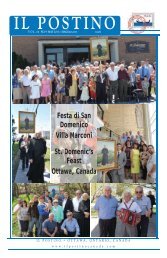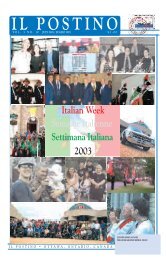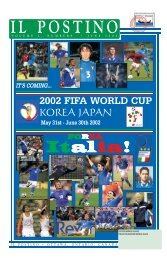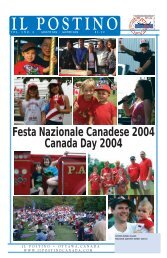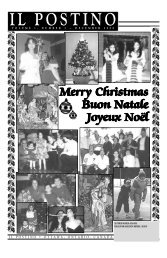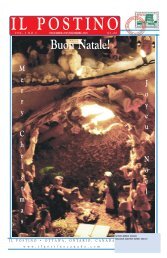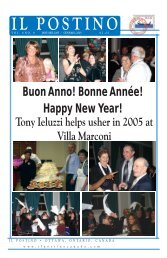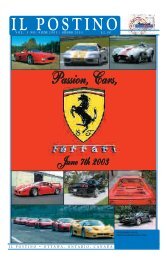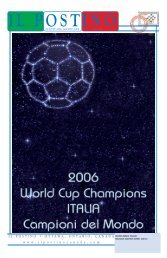Buon Natale! Buon Natale! - Il Postino Canada
Buon Natale! Buon Natale! - Il Postino Canada
Buon Natale! Buon Natale! - Il Postino Canada
You also want an ePaper? Increase the reach of your titles
YUMPU automatically turns print PDFs into web optimized ePapers that Google loves.
Page 6<br />
I L P O S T I N O<br />
by Antonio Maglio<br />
Originally published in Tandem News<br />
Once upon a time, in Australia’s Queensland, the Party. A heroic endeavour in a country that had began as<br />
sugar cane was harvested by Kakanas, Melanesian half- a penal colony and still had not lost some characteristic<br />
slaves. When forced to replace them, the colonial gov- traits of that period.<br />
ernment recruited 335 peasants from the Veneto. That The life of political exiles was not a bed of roses; the<br />
was in 1891. Thus began Italian emigration to Australia. same applied to the workers who were beginning to<br />
The job was awful. The cane could only be cut after come from Italy. When those 335 Venetians were called<br />
burning the bush and driving away mice, scorpions and to replace the Kakanas, the powerful Workers’ Union<br />
snakes; then the real machete work began. It went on denounced the fact that the Italians, willing to work<br />
from the early morning light for as long as the worker harder than the slaves and to accept low wages, would<br />
could stand, because the wages were based on piece- in the long run take jobs away from Australians. Over<br />
work. Those who survived that hell were uncommon 8,000 Queensland farmers signed a petition asking the<br />
men. The Venetian peasants sur-<br />
government to kill the<br />
vived.<br />
project replacing the<br />
However, Australia was not<br />
Kakanas with Italians.<br />
unknown to Italians. A decade<br />
The petition was ignored,<br />
earlier, in fact, some fishermen<br />
and for decades Italians<br />
from Molfetta, the Eolian Islands<br />
kept cutting sugar cane,<br />
and Capo d’Orlando had already<br />
eventually becoming<br />
come looking for fortune. A few<br />
owners of some farms<br />
dozen people, but by the turn of<br />
themselves. The hostility<br />
the century they had vigorously<br />
from White Australia<br />
contributed to modernizing and<br />
would accompany them<br />
boosting the fishing industry in<br />
for a long time.<br />
Fremantle, where they had set-<br />
“The constant inflow of<br />
tled down. Before them, only<br />
Italians,” remarks Gaetano<br />
missionaries, political exiles and<br />
Rando, “was seen with ap-<br />
artists had reached the end of the<br />
prehension by that part of<br />
world. People like father Salvado<br />
the population that wor-<br />
(who sported a musical name,<br />
ried about safeguarding<br />
Rudesindo), for instance, who<br />
racial purity and social har-<br />
wrote his Memorie storiche<br />
dell’Australia, particolarmente<br />
Italian sugar cane cutters in Queensland<br />
mony. The Labour Party<br />
and the trade unions were<br />
della Missione Benedettina di Nuova Norcia e dei costumi afraid of the repercussions on unemployment of those<br />
degli Australiani (“Historical memories of Australia, par- arrivals. The press fuelled worries and fears.”<br />
ticularly of the Benedictine Mission of New Norcia and In 1883 the Bulletin of Sydney wrote that Italians were<br />
of the customs of Australians”) upon his return to Italy in grossly ignorant and brought with them jack knives and<br />
1851. The title may be long, as was fashionable at the contagious diseases. For years other newspapers would<br />
time, but the book has historic value. It was the first book follow suit, competing in evidencing negative traits of Ital-<br />
on Australia ever published in Italy.<br />
ians. In the course of this “meritorious” campaign, they<br />
Raffaello Carboni, a follower of Garibaldi and Mazzini, promoted Italians from dirty dagos (a definition shared<br />
who had to leave Italy after the fall of the Roman Repub- with Portuguese and Spaniards) to mafiosi tout court.<br />
lic (1849), arrived Down Under in 1854. He was less than When, in 1924, a steamship with 1,090 Calabrians,<br />
fascinated by the political situation he found. “In fact, Apulians and Friulians docked, those newspapers wrote<br />
the British colonial rule was all but enlightened. It was that Italy was invading Australia. The sense of measure<br />
fundamentally racist, and no less repressive than the Ital- (and of the ridiculous) was in short supply among those<br />
ian governments of the time,” explains Gaetano Rando, journalists.<br />
historian of Italian emigration to Australia. “What particu- Considering this climate, one cannot be amazed that<br />
larly struck Carboni was the absence of the ideals of de- in 1930 the farmers of the Murrumbridgee Irrigation Area,<br />
mocracy, equality and liberty that were present in the supported by the town dwellers, proposed that the au-<br />
European progressive movements.”<br />
thorities forbid Italians from purchasing lands and farms.<br />
Those ideals were brought to Australia mainly by Ital- In the same period the British Preference League was<br />
ian political exiles. Francesco Sceusa, forced to leave formed, with an exemplary program: excluding foreign<br />
Trapani because of his ideas, arrived in Sydney in 1877, workers, Italians first and foremost, from any employ-<br />
and for the next 30 years was a Socialist activist inside ment; an alternative was mass deportation. Once again<br />
and outside the small Italian community. And a textile nothing came of it, but the episode exemplifies the cli-<br />
worker from Schio, Pietro Munari, who arrived in 1890, mate surrounding Italians.<br />
became one of the founders of the Australian Labour The war did nothing to improve the situation: Italy<br />
International Tailors<br />
IL POSTINO • OTTAWA, ONTARIO, CANADA<br />
December 2002<br />
Italians were replacements for slaves<br />
Turn-of-century immigrants to Australia<br />
were subject to racist attacks by residents<br />
Che la Notte di <strong>Natale</strong> sia colma di felicità e<br />
di pace e che il Nuovo Anno sia per tutti voi<br />
apportatore di gioia, serenità e prosperità<br />
and Australia fought on opposing sides, and like in the<br />
United States and <strong>Canada</strong>, our fellow nationals were interned<br />
in concentration camps. Almost 5,000 of them.<br />
But the war itself brought a change. During the war<br />
18,000 Italian POWs were deported to Australia. They<br />
were given the choice of concentration camp or farm<br />
work. Almost 15,000 chose the farms. Evidently, the war<br />
had shown where racism and intolerance could lead, as<br />
those 15,000 were accepted with a different spirit, and<br />
their work made the fortune of many agricultural areas.<br />
After the fighting was over, Italian prisoners returned<br />
home, but many of them immediately went back to Australia,<br />
receiving a warm welcome. Stimulated by this<br />
experience, the government launched a solid policy of<br />
immigration, the only way for building and populating<br />
such an immense country and exploit its resources.<br />
From then on, Australia, with <strong>Canada</strong> and Venezuela,<br />
became one of the objectives of Italian emigrants, especially<br />
because the traditional destinations (mostly the<br />
U.S.A. and Argentina) were increasingly difficult to get<br />
to. Washington and Buenos Aires, in fact, had enacted<br />
harsh measures discouraging immigration; Argentina in<br />
the Fifties was shaken by a grave recession of the<br />
economy coupled with heavy inflation. Australia was far,<br />
very far away, but it had jobs and a solid economy, and<br />
the climate was similar to that of Italy. So, many Italians<br />
left, bound for the other side of the world.<br />
“Many among them did so with the intention of never<br />
going back, or at least of staying for a long time,” says<br />
Carlo Coen, who knows Australia quite well because,<br />
before Toronto, he directed Melbourne’s Istituto Italiano<br />
di Cultura. “The distance played a key roll. You cannot go<br />
back and forth easily when the place is over a month<br />
away. But there was also an immense, almost unexplored<br />
country, where one could really start a new life. And this<br />
is what many Italians wanted, after the war. These<br />
premises have two main consequences. The first is that<br />
Italians have a close link with Australia, maybe closer<br />
than other immigrants have with other countries. The<br />
second concerns remittances, the money they saved.”<br />
Coen explains, “Little money was sent to Italy by Italian-Australians.<br />
They preferred keeping their savings to<br />
themselves, using them to bring over their families or to<br />
open a business in Australia. In short, returning was a<br />
rather remote idea for them. A different situation applied<br />
to those who emigrated within Europe or even in the<br />
Americas, relatively closer places, that fuelled the dream<br />
of returning. Their remittances brought wealth to their<br />
families and robustly helped Italian economy.”<br />
For years Rocco Cudazzo (the name has been<br />
changed, but the story is true), a miner in Marcinelle,<br />
Belgium, sent his savings home, in a whitewashed village<br />
in the province of Lecce. “I want to buy a house, a<br />
shop and a grave, because I want to go home,” he told<br />
his friends.<br />
He used only the grave: a sudden firedamp explosion<br />
in the big mine cut his dreams short. The year was 1958.<br />
Order of Italo-Canadians<br />
Fervidi auguri di un Gioioso <strong>Natale</strong> e un<br />
Anno Nuovo colmo di Benessere e<br />
Prosperità a tutta la comunità Italiana




